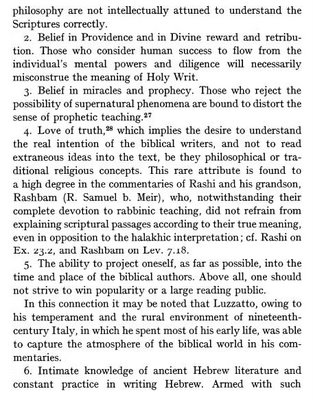They are:
- Believe in God as creator *
- Believe in the divine providence of reward and punishment *
- Believe in miracles and prophecy *
- Dedicate oneself to the true interpretation of the text rather than reading in your worldview onto it *
- Put oneself back in time in order to understand Tanakh in the context in which it was understood by its original biblical audience *
- Be fluent in reading and writing Hebrew and ancient Jewish texts *
- Be expert in the טעמי המקרא, (cantillation) and know how to derive meaning from them *
- Have or nurture a poetic spirit in order to understand biblical poetry *
- The explanation of חז"ל might not be the פשט *
- The ספרי הקודש were always faithfully guarded and maintained *
This is a very interesting and wonderful list. Of course my short summary is only that. At this time I have not prepared a translation of his principles, but a better summary can be read here (click for easier reading) :



(from Samuel David Luzzatto as Exegete by Israel Abrahams in JQR 57:2 (Oct. 1966)
Some are rather straightforward but some need additional explanation and background. For example, the fifth יסוד seems to be identical to the historical-critical method, but it is not, because Shadal accepted upon himself dogmatic constraints. Furthermore, what reasonably seemed to be in no way reading into texts in the 19th century might very well be considered to be that today and that ought to be kept in mind.
The tenth is open to question since there is a minimalist and maximalist interpretation of that idea expecially given Shadal's own practices one must wonder what he meant by that.
I intend to explore some of the principles as well as seeming contradictions in Shadal in the next post, Part II.





No comments:
Post a Comment